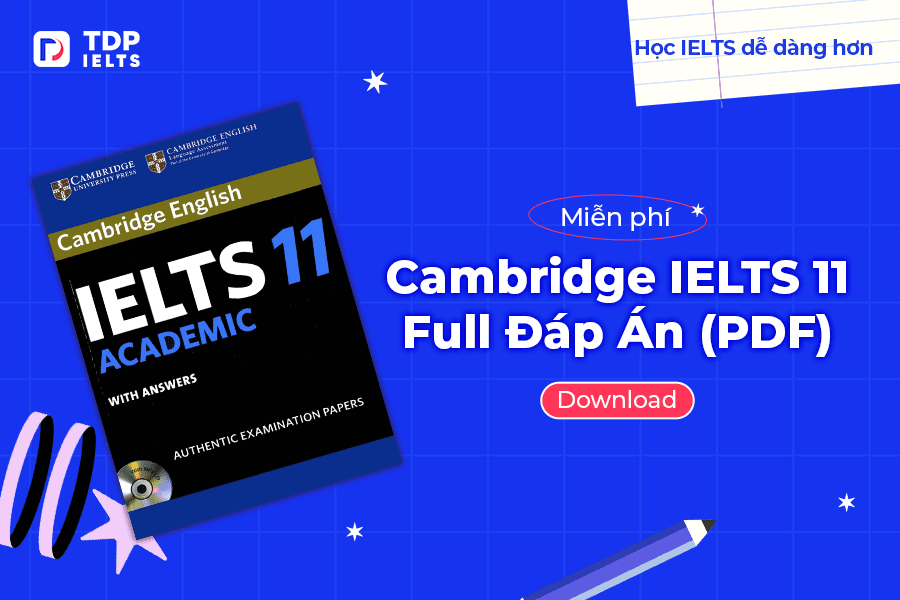Matching Heading IELTS Reading là dạng bài nối tiêu đề khó nhằn nhất trong các bài thi Reading. Dạng bài này đòi hỏi thí sinh phải có kiến thức từ vựng phong phú cùng khả năng đọc hiểu văn bản tốt. TDP IELTS xin mách nhỏ vài mẹo ôn luyện dạng đề này!

Nội dung
ToggleMatching Heading là gì?
Matching Heading IELTS Reading là dạng bài mà người thi được đưa ra từ 5-9 headings và nối những heading đó với những đoạn văn tương ứng với nội dung của chúng.
Để làm dạng câu hỏi này, bạn cần nắm được chủ đề chính của đoạn văn. Các đoạn văn thường được ký hiệu A, B, C… và các tiêu đề đánh số I, ii, iii… Thường sẽ có nhiều tiêu đề hơn đoạn văn. Các tiêu đề sẽ được đặt trước.
Tìm hiểu thêm: Lộ trình học IELTS từ 0 đến 6.5+ cho người mới bắt đầu chi tiết nhất
Vì sao Matching Heading lại khó?
Với một số thí sinh, các trở ngại khi làm dạng bài này sẽ là:
- Tốn nhiều thời gian.
- Có nhiều câu tiêu để hơn đoạn văn, dễ gây thông tin sai lệch.
- Một vài tiêu đề khá tương đồng nhau.
- Các tiêu đề có thể được sử dụng để đánh lạc hướng thí sinh.
- …
Vậy làm thế nào để vượt qua dạng bài khó nhằn này? Hãy tham khảo cách sau:
Bật mí cách làm bài Matching Heading trong IELTS siêu đơn giản
Dạng bài Heading Matching IELTS Reading sẽ không thể làm khó bạn khi áp dụng 4 bước sau:
Bước 1: Đọc các tiêu đề (headings) trước. Cố gắng xác định từ khóa của từng tiêu đề. Để ý kỹ các từ lặp đi lặp lại nhiều trong các tiêu đề (đây là ý chính của toàn bài văn bạn sắp đọc)
Bước 2: Đọc và tìm ý chính của đoạn văn đầu tiên. Đọc kỹ câu đầu và cuối đoạn vì ý chính thường nằm ở hai câu này. Đọc lướt phần còn lại, bỏ qua các chi tiết.
Bước 3: Đọc kỹ các tiêu đề một lần nữa để chọn câu trả lời phù hợp nhất cho ý chính của đoạn văn vừa đọc
- Tips:
-
- Bạn có thể loại các đáp án chắc chắn sai bằng cách bỏ qua những tiêu đề có các từ khóa chưa được nhắc đến trong đoạn văn vừa đọc.
- Cố gắng tìm điểm khác biệt của các tiêu đề gần giống nhau để tránh nhầm lẫn khi chọn
- Đừng dành quá nhiều thời gian cho một đoạn văn. Bạn có thể quay lại câu chưa làm được sau khi đã hoàn thành các đoạn khác.
- Các tiêu đề thường sẽ dùng từ đồng nghĩa (synonyms) hoặc diễn đạt lại ý chính của đoạn (paraphrase).
- Gạch bỏ các tiêu đề đã chọn để tránh phân tâm.
Bước 4: Lặp lại bước 2 và 3 cho toàn bài.
Bài tập mẫu Matching Heading IELTS Reading
| List of headings
i The future of urban planning in America ii Conflicting ideas through the history of urban planning iii Urban planning has a long and varied history iv Financial problems helped spread an urban planning concept v The background to one particular planned community vi Political change obstructs progress in urban planning vii An urban plan to reduce traffic |
A
The notion of planning entire communities prior to their construction is an ancient one. In fact, one of the earliest such cities on record is Miletus, Greece, which was built in the 4th century BC. Throughout the Middle Ages and the Renaissance, various planned communities (both theoretical and actual) were conceived. Leonardo da Vinci designed several cities that were never constructed. Following the Great Fire of London in 1666, the architect Christopher Wren created a new master plan for the city, incorporating park land and urban space. Several 18th-century cities, including Washington D.C., New York City, and St Peterburg, Russia, were built according to comprehensive planning.
B
One of the most important planned city concepts, the Garden City Movement, arose in the latter part of the 19th century as a reaction to the pollution and crowding of the Industrial Revolution. In 1898, Ebenezer Howard published the book To-Morrow: A Peaceful Path to Real Reform in which he laid out his ideas concerning the creation of new economically viable towns. Howard believed that these towns should be limited in size and density, and surrounded with a belt of undeveloped land. The idea gained enough attention and financial backing to lead to the creation of Letchworth, in Hertfordshire, England. This was the first such ‘Garden City’. After the First World War, the second town built following Howard’s ideas, Welwyn Garden City, was constructed.
C
In the early 1920s, American architects Clarence Stein and Henry Wright, inspired by Howard’s ideas and the success of Letchworth and Welwyn, created the city of Radburn, New Jersey. Conceived as a community which would be safe for children, Radburn was intentionally designed so that the residents would not require automobiles. Several urban planning designs were pioneered at Radburn that would influence later planned communities, including the separation of pedestrians and vehicles, and the use of ‘superblocks’, each of which shared 23 acres of commonly held parkland.
D
In America, following the stock market crash of 1929, there was great demand for both affordable housing and employment for workers who had lost their jobs. In direct response to this, in 1935 President Roosevelt created the Resettlement Administration, which brought about a total of three greenbelt towns: Greenbelt, Maryland; Greenhills, Ohio; and Greendale, Wisconsin. These towns contained many of the elements of the Garden City Movement developments, including the use of superblocks and a ‘green belt’ of undeveloped land surrounding the community.

Hướng dẫn chi tiết cách làm dạng bài Matching Heading IELTS Reading
| Bước | Cách làm | Giải thích |
| 1. Đọc các tiêu đề (headings) trước.
– Cố gắng xác định từ khóa của từng tiêu đề. – Để ý kỹ các từ lặp đi lặp lại nhiều trong các tiêu đề (ý chính của toàn bài văn bạn sắp đọc) |
i The future of urban planning in America
ii Conflicting ideas through the history of urban planning iii Urban planning has a long and varied history iv Financial problems helped spread an urban planning concept v The background to one particular planned community vi Political change obstructs progress in urban planning vii An urban plan to reduce traffic
|
– Các từ khóa (từ mang thông tin cụ thể) đã được gạch chân.
– Các từ “urban, plan” và “planning” lặp đi lặp lại 🡪 Đoạn văn nói về “urban planning” |
| 2. Đọc và tìm ý chính của đoạn văn đầu tiên.
– Đọc kỹ câu đầu và cuối đoạn vì ý chính thường nằm ở hai câu này. – Đọc lướt phần còn lại, bỏ qua các chi tiết.
|
A
The notion of planning entire communities prior to their construction is an ancient one. In fact, one of the earliest such cities on record is Miletus, Greece, which was built in the 4th century BC. Throughout the Middle Ages and the Renaissance, various planned communities (both theoretical and actual) were conceived. Leonardo da Vinci designed several cities that were never constructed. Following the Great Fire of London in 1666, the architect Christopher Wren created a new master plan for the city, incorporating park land and urban space. Several 18th-century cities, including Washington D.C., New York City, and St Peterburg, Russia, were built according to comprehensive planning.
|
Hai câu đầu và câu cuối của đoạn A nhắc nhiều đến các sự kiện liên quan đến “urban planning” diễn ra trong quá khứ. Các câu văn còn lại cũng nói về các sự kiện trong quá khứ.
🡪 ý chính của đoạn là “the history of urban planning” |
| 3. Chọn câu trả lời phù hợp nhất cho ý chính của đoạn văn vừa đọc
– Loại các đáp án chắc chắn sai – Tìm điểm khác biệt của các tiêu đề gần giống – Để ý kỹ các từ đồng nghĩa (synonyms) hoặc diễn đạt lại ý chính của đoạn (paraphrase).
|
– Ý chính của đoạn: history
– Các tiêu đề giống nhau: ii Conflicting ideas through the history of urban planning iii Urban planning has a long and varied history (các tiêu đề khác không liên quan đến “history” nên có thể loại ngay) – Loại tiêu đề iii vì đoạn A không có thông tin về “conflicting ideas”
|
🡪 Đáp án đúng
Tiêu đề iii: Urban planning has a long and varied history
|
| 4. Lặp lại các bước trên cho toàn bài | B
One of the most important planned city concepts, the Garden City Movement, arose in the latter part of the 19th century as a reaction to the pollution and crowding of the Industrial Revolution. In 1898, Ebenezer Howard published the book To-Morrow: A Peaceful Path to Real Reform in which he laid out his ideas concerning the creation of new economically viable towns. Howard believed that these towns should be limited in size and density, and surrounded with a belt of undeveloped land. The idea gained enough attention and financial backing to lead to the creation of Letchworth, in Hertfordshire, England. This was the first such ‘Garden City’. After the First World War, the second town built following Howard’s ideas, Welwyn Garden City, was constructed. |
– Ý chính: Giải thích lý do dẫn đến sự ra đời (the background) của Letchworth – dự án “Garden City” đầu tiên (one particular planned community)
🡪 Đáp án đúng: Heading v: The background to one particular planned community
|
| C
In the early 1920s, American architects Clarence Stein and Henry Wright, inspired by Howard’s ideas and the success of Letchworth and Welwyn, created the city of Radburn, New Jersey. Conceived as a community which would be safe for children, Radburn was intentionally designed so that the residents would not require automobiles. Several urban planning designs were pioneered at Radburn that would influence later planned communities, including the separation of pedestrians and vehicles, and the use of ‘superblocks’, each of which shared 23 acres of commonly held parkland. |
– Ý chính: thiết kế của thành phố Radburn, America (an urban plan), được xây với mục đích tạo ra một môi trường ít phương tiện giao thông để an toàn cho trẻ em (reduce traffic)
– Paraphrase: + reduce traffic = not require automobiles
🡪 Đáp án đúng: Heading vii: An urban plan to reduce traffic
|
|
| D
In America, following the stock market crash of 1929, there was great demand for both affordable housing and employment for workers who had lost their jobs. In direct response to this, in 1935 President Roosevelt created the Resettlement Administration, which brought about a total of three greenbelt towns: Greenbelt, Maryland; Greenhills, Ohio; and Greendale, Wisconsin. These towns contained many of the elements of the Garden City Movement developments, including the use of superblocks and a ‘green belt’ of undeveloped land surrounding the community. |
– Ý chính: Tác động của “the stock market crash, unemployment, and a lack of affordable housing” (financial problems) đến nước Mỹ và cách vị Tổng thống ứng phó bằng cách xây dựng thêm nhiều “garden cities”
🡪 Đáp án đúng: Heading iv: Financial problems helped spread an urban planning concept
|
Matching Heading IELTS Practice – Luyện tập dạng bài Matching Headings IELTS
Dưới đây là các bài tập Matching Heading có đáp án được đội ngũ giảng viên TDP IELTS sưu tập lại.
Practice test 41
The text on the following pages has six paragraphs, A – F
Choose the correct heading for each paragraph from the list of headings (i – ix) below.
Write the correct number, i – ix, in boxes 1–6 on your answer sheet.
| List of Headings
i Tackling the issue using a different approach ii A significant improvement on last time iii How robots can save human lives iv Examples of robots at work v Not what it seemed to be vi Why timescales are impossible to predict vi The reason why robots rarely move vii Following the pattern of an earlier development ix The ethical issues of robotics |
1 Paragraph A …………………
2 Paragraph B …………………
3 Paragraph C …………………
4 Paragraph D …………………
5 Paragraph E …………………
6 Paragraph F …………………
A
At first sight, it looked like a typical suburban road accident. A Land Rover approached a Chevy Tahoe estate car that had stopped at a kerb; the Land Rover pulled out and tried to pass the Tahoe just as it started off again. There was a crack of fenders and the sound of paintwork being scraped, the kind of minor mishap that occurs on roads thousands of times every day. Normally drivers get out, gesticulate, exchange insurance details and then drive off. But not on this occasion. No one got out of the cars for the simple reason that they had no humans inside them; the Tahoe and Land Rover were being controlled by computers competing in November’s DARPA (the U.S. Defence Advanced Research Projects Agency) Urban Challenge.
B
The idea that machines could perform to such standards is startling. Driving is a complex task that takes humans a long time to perfect. Yet here, each car had its onboard computer loaded with a digital map and route plans, and was instructed to negotiate busy roads; differentiate between pedestrians and stationary objects; determine whether other vehicles were parked or moving off; and handle various parking manoeuvres, which robots turn out to be unexpectedly adept at. Even more striking was the fact that the collision between the robot Land Rover, built by researchers at the Massachusetts Institute of Technology, and the Tahoe, fitted out by Cornell University Artificial Intelligence (AI) experts, was the only scrape in the entire competition. Yet only three years earlier, at DARPA’s previous driverless car race, every robot competitor directed to navigate across a stretch of open desert either crashed or seized up before getting near the finishing line.
C
It is a remarkable transition that has clear implications for the car of the future. More importantly, it demonstrates how robotics sciences and Artificial Intelligence have progressed in the past few years a point stressed by Bill Gates, the Microsoft boss who is a convert to these causes. The robotics industry is developing in much the same way the computer business did 30 years ago,’ he argues. As he points out, electronics companies make toys that mimic pets and children with increasing sophistication. ‘I can envision a future in which robotic devices will become a nearly ubiquitous part of our day-to-day lives,’ says Gates. ‘We may be on the verge of a new era, when the PC will get up off the desktop and allow us to see, hear, touch and manipulate objects in places where we are not physically present.’
D
What is the potential for robots and computers in the near future? The fact is we still have a way to go before real robots catch up with their science fiction counterparts/ Gates says. So what are the stumbling blocks? One key difficulty is getting robots to know their place. This has nothing to do with class or etiquette, but concerns the simple issue of positioning. Humans orient themselves with other objects in a room very easily. Robots find the task almost impossible. ‘Even something as simple as telling the difference between an open door and a window can be tricky for a robot,’ says Gates. This has, until recently, reduced robots to fairly static and cumbersome roles.
E
For a long time, researchers tried to get round the problem by attempting to recreate the visual processing that goes on in the human cortex. However, that challenge has proved to be singularly exacting and complex. So scientists have turned to simpler alternatives: ‘We have become far more pragmatic in our work,’ says Nello Cristianini, Professor of Artificial Intelligence at the University of Bristol in England and associate editor of the Journal of Artificial Intelligence Research. ‘We are no longer trying to recreate human functions. Instead, we are looking for simpler solutions with basic electronic sensors, for example.’ This approach is exemplified by vacuuming robots such as the Electrolux Trilobite. The Trilobite scuttles around homes emitting ultrasound signals to create maps of rooms, which are remembered for future cleaning. Technology like this is now changing the face of robotics, says philosopher Ron Chrisley, director of the Centre for Research in Cognitive Science at the University of Sussex in England.
F
Last year, a new Hong Kong restaurant, Robot Kitchen, opened with a couple of sensor laden humanoid machines directing customers to their seats. Each possesses a touchscreen on which orders can be keyed in. The robot then returns with the correct dishes. In Japan, University of Tokyo researchers recently unveiled a kitchen ‘android’ that could wash dishes, pour tea and make a few limited meals. The ultimate aim is to provide robot home helpers for the sick and the elderly, a key concern in a country like Japan where 22 per cent of the population is 65 or older. Over US$1 billion a year is spent on research into robots that will be able to care for the elderly. ‘Robots first learn basic competence how to move around a house without bumping into things. Then we can think about teaching them how to interact with humans,’ Chrisley said. Machines such as these take researchers into the field of socialised robotics: how to make robots act in a way that does not scare or offend individuals. ‘We need to study how robots should approach people, how they should appear. That is going to be a key area for future research,’ adds Chrisley.
Practice test 42
The following Reading Passage has seven paragraphs, A–G.
Choose the correct heading for each paragraph from the list of headings below.
Write the correct number, i–x, in boxes 1–7 on your answer sheet.
| List of Headings
i A unique sensory experience ii Getting back to basics iii The gift that keeps on giving iv Variations in alcohol content v Old methods of transportation vi Culinary applications vii Making kefir viii A fortunate accident ix Kefir gets an image makeover x Ways to improve taste |
1 Paragraph A …………………
2 Paragraph B …………………
3 Paragraph C …………………
4 Paragraph D …………………
5 Paragraph E …………………
6 Paragraph F …………………
7 Paragraph G …………………
The MAGIC of KEFIR
A
The shepherds of the North Caucasus region of Europe were only trying to transport milk the best way they knew how – in leather pouches strapped to the side of donkeys – when they made a significant discovery. A fermentation process would sometimes inadvertently occur en route, and when the pouches were opened upon arrival they would no longer contain milk but rather a pungent, effervescent, low alcoholic substance instead. This unexpected development was a blessing in disguise. The new drink – which acquired the name kefir – turned out to be a health tonic, a naturally-preserved dairy product and tasty addition to our culinary repertoire.
B
Although their exact origin remains a mystery, we do know that yeast-based kefir grains have always been at the root of the kefir phenomenon. These grains are capable of a remarkable feat: in contradistinction to most other items you might find in a grocery store, they actually expand and propagate with use. This is because the grains, which are granular to the touch and bear a slight resemblance to cauliflower rosettes, house active cultures that feed on lactose when added to milk. Consequently, a bigger problem for most kefir drinkers is not where to source new kefir grains, but what to do with the ones they already have!
C
The great thing about kefir is that it does not require a manufacturing line in order to be produced. Grains can be simply thrown in with a batch of milk for ripening to begin. The mixture then requires a cool, dark place to live and grow, with periodic unsettling to prevent clumping (Caucasus inhabitants began storing the concoction in animal-skin satchels on the back of doors – every time someone entered the room the mixture would get lightly shaken). After about 24 hours the yeast cultures in the grains have multiplied and devoured most of the milk sugars, and the final product is then ready for human consumption.
D
Nothing compares to a person’s first encounter with kefir. The smooth, uniform consistency rolls over the tongue in a manner akin to liquefied yogurt. The sharp, tart pungency of unsweetened yogurt is there too, but there is also a slight hint of effervescence, something most users will have previously associated only with mineral waters, soda or beer. Kefir also comes with a subtle aroma of yeast, and depending on the type of milk and ripening conditions, ethanol content can reach up to two or three percent – about on par with a decent lager – although you can expect around 0.8 to one per cent for a typical day-old preparation. This can bring out a tiny edge of alcohol in the kefir’s flavour.
E
Although it has prevailed largely as a fermented milk drink, over the years kefir has acquired a number of other uses. Many bakers use it instead of starter yeast in the preparation of sourdough, and the tangy flavour also makes kefir an ideal buttermilk substitute in pancakes. Kefir also accompanies sour cream as one of the main ingredients in cold beetroot soup and can be used in lieu of regular cow’s milk on granola or cereal. As a way to keep their digestive systems fine-tuned, athletes sometimes combine kefir with yoghurt in protein shakes.
F
Associated for centuries with pictures of Slavic babushkas clutching a shawl in one hand and a cup of kefir in the other, the unassuming beverage has become a minor celebrity of the nascent health food movement in the contemporary West. Every day, more studies pour out supporting the benefits of a diet high in probiotics1. This trend toward consuming probiotics has engulfed the leisure classes in these countries to the point that it is poised to become, according to some commentators, “the next multivitamin”. These days the word kefir is consequently more likely to bring to mind glamorous, yoga mat-toting women from Los Angeles than austere visions of blustery Eastern Europe.
G
Kefir’s rise in popularity has encouraged producers to take short cuts or alter the production process. Some home users have omitted the ripening and culturation process while commercial dealers often add thickeners, stabilisers and sweeteners. But the beauty of kefir is that, at its healthiest and tastiest, it is a remarkably affordable, uncluttered process, as any accidental invention is bound to be. All that is necessary are some grains, milk and a little bit of patience. A return to the unadulterated kefir-making of old is in everyone’s interest.
——————
1 Probiotic = substance containing beneficial and intestine-friendly microorganisms
Practice test 43
The following Reading Passage has nine paragraphs, A–I.
Choose the correct heading for paragraphs A–H from the list of headings below.
Write the correct number, i–xi, in boxes 1–8 on your answer sheet.
| List of Headings
i A historical delicacy ii The poor may benefit iii Presentation is key to changing attitudes iv Environmentally friendly production v Tradition meets technology vi A cultural pioneer vii Western practices harm locals viii Good source of nutrient ix Growing popularity x A healthy choice xi A safety risk |
1 Paragraph A …………………
2 Paragraph B …………………
3 Paragraph C …………………
4 Paragraph D …………………
5 Paragraph E …………………
6 Paragraph F …………………
7 Paragraph G …………………
8 Paragraph H …………………
FOOD FOR THOUGHT
A
Why not eat insects? So asked British entomologist Vincent M. Holt in the title of his 1885 treatise on the benefits of what he named entomophagy – the consumption of insects (and similar creatures) as a food source. The prospect of eating dishes such as “wireworm sauce” and “slug soup” failed to garner favour amongst those in the stuffy, proper, Victorian social milieu of his time, however, and Holt’s visionary ideas were considered at best eccentric, at worst an offense to every refined palate. Anticipating such a reaction, Holt acknowledged the difficulty in unseating deep-rooted prejudices against insect cuisine, but quietly asserted his confidence that “we shall some day quite gladly cook and eat them”.
B
It has taken nearly 150 years but an eclectic Western-driven movement has finally mounted around the entomophagic cause. In Los Angeles and other cosmopolitan Western cities, insects have been caught up in the endless pursuit of novel and authentic delicacies. “Eating grasshoppers is a thing you do here”, bug-supplier Bricia Lopez has explained. “There’s more of a ‘cool’ factor involved.” Meanwhile, the Food and Agricultural Organization has considered a policy paper on the subject, initiated farming projects in Laos, and set down plans for a world congress on insect farming in 2013.
C
Eating insects is not a new phenomenon. In fact, insects and other such creatures are already eaten in 80 per cent of the world’s countries, prepared in customary dishes ranging from deep-fried tarantula in Cambodia to bowls of baby bees in China. With the specialist knowledge that Western companies and organisations can bring to the table, however, these hand-prepared delicacies have the potential to be produced on a scale large enough to lower costs and open up mass markets. A new American company, for example, is attempting to develop pressurisation machines that would de-shell insects and make them available in the form of cutlets. According to the entrepreneur behind the company, Matthew Krisiloff, this will be the key to pleasing the uninitiated palate.
D
Insects certainly possess some key advantages over traditional Western meat sources. According to research findings from Professor Arnold van Huis, a Dutch entomologist, breeding insects results in far fewer noxious by-products. Insects produce less ammonia than pig and poultry farming, ten times less methane than livestock, and 300 times less nitrous oxide. Huis also notes that insects – being cold-blooded creatures – can convert food to protein at a rate far superior to that of cows, since the latter exhaust much of their energy just keeping themselves warm.
E
Although insects are sometimes perceived by Westerners as unhygienic or disease-ridden, they are a reliable option in light of recent global epidemics (as Holt pointed out many years ago, insects are “decidedly more particular in their feeding than ourselves”). Because bugs are genetically distant from humans, species-hopping diseases such as swine flu or mad cow disease are much less likely to start or spread amongst grasshoppers or slugs than in poultry and cattle. Furthermore, the squalid, cramped quarters that encourage diseases to propagate among many animal populations are actually the residence of choice for insects, which thrive in such conditions.
F
Then, of course, there are the commercial gains. As FAO Forestry Manager Patrick Durst notes, in developing countries many rural people and traditional forest dwellers have remarkable knowledge about managing insect populations to produce food. Until now, they have only used this knowledge to meet their own subsistence needs, but Durst believes that, with the adoption of modern technology and improved promotional methods, opportunities to expand the market to new consumers will flourish. This could provide a crucial step into the global economic arena for those primarily rural, impoverished populations who have been excluded from the rise of manufacturing and large-scale agriculture.
G
Nevertheless, much stands in the way of the entomophagic movement. One problem is the damage that has been caused and continues to be caused, by Western organisations prepared to kill off grasshoppers and locusts – complete food proteins – in favour of preserving the incomplete protein crops of millet, wheat, barley and maize. Entomologist Florence Dunkel has described the consequences of such interventions. While examining children’s diets as a part of her field work in Mali, Dunkel discovered that a protein deficiency syndrome called kwashiorkor was increasing in incidence. Children in the area were once protected against kwashiorkor by a diet high in grasshoppers, but these had become unsafe to eat after pesticide use in the area increased.
H
A further issue is the persistent fear many Westerners still have about eating insects. “The problem is the ick factor—the eyes, the wings, the legs,” Krisiloff has said. “It’s not as simple as hiding it in a bug nugget. People won’t accept it beyond the novelty. When you think of a chicken, you think of a chicken breast, not the eyes, wings, and beak.” For Marcel Dicke, the key lies in camouflaging the fact that people are eating insects at all. Insect flour is one of his propositions, as is changing the language of insect cuisine. “If you say it’s mealworms, it makes people think of ringworm”, he notes. “So stop saying ‘worm’. If we use Latin names, say it’s a Tenebrio quiche, it sounds much more fancy”. For Krisiloff, Dicke and others, keeping quiet about the gritty reality of our food is often the best approach.
I
It is yet to be seen if history will truly redeem Vincent Holt and his suggestion that British families should gather around their dining tables for a breakfast of “moths on toast”. It is clear, however, that entomophagy, far from being a kooky sideshow to the real business of food production, has much to offer in meeting the challenges that global societies in the 21st century will face.
Xem thêm: Chiến thuật làm bài Matching Sentence Endings IELTS Reading
Lời kết
Trên đây là những chia sẽ của TDP IELTS về Matching Heading IELTS Reading hiệu quả nhất. Bên cạnh những bài tập nêu trên, bạn có thể tham khảo thêm sách tài liệu Matching Headings IELTS Practice pdf trên internet hoặc liên hệ với TDP IELTS để được giải đáp thắc mắc!











